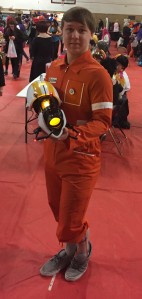By Stacey Longo
VWars: Blood and Fire is the second installment in the VWars series, edited and co-authored by New York Times bestselling author Jonathan Maberry, featuring such talented writers as Kevin J. Anderson, Larry Correia, Joe McKinney, James A. Moore, Yvonne Navarro, Weston Ochse, and Scott Sigler. The book is set up in a manner reminiscent of World War Z, in which the reader is treated to snippets of the escalating battle between the “Beats” (humans) and the “Bloods” (vampires). No need to worry if you haven’t read the first one (though I do recommend the first installment): the anthology is character-driven, engaging, and sucks the reader in from the first page.
Maberry leads off with “Apocalypse Tango” (broken up into seven parts and interspersed between other stories, as many of the tales in this book are), which introduces us to Luther Swann, an important figure throughout this book. This story maps out what’s going on—families are getting slaughtered, tensions are escalating, and Swann is unable to prevent what appears to be another war against the vampires.
“The Enemy Within” is a solid entry from Yvonne Navarro, who introduces us to Mooney, a vampire uncomfortable with her new status. She becomes immersed in local vamp infighting. Mooney is an intriguing character, and this story will have you hoping that Mooney gets her own novel someday.
Joe McKinney introduces us to thirteen-year-old Ernesto in “Tenochtitlan Will Rise,” showcasing yet another facet of the developing tensions. Through Ernesto, who is just trying to take care of his grandfather, we see how closely war can hit home.
“War Torn,” the piece from James A. Moore, creates an engaging voice in Johnny Lei. Lei is empathetic, and you’ll find yourself rooting for the misunderstood vampire, until he reminds you that first and foremost, he is a predator.
“Suicide Games,” also by Maberry, lets us know that there’s more to fear in this war than just vampires and humans.
Next up is “Solitude” by Kevin J. Anderson, a standalone piece about a veteran of Afghanistan who just wants to be left alone. It’s intriguing and haunting.
Maberry pops back in with “Let God Sort ’Em Out,” in which we’re treated to battle scenes, the internal struggle that our old friend Swann continues to deal with, and the introduction of a dynamic new character, Big Dog.
“Manifest Destiny” is Weston Ochse’s contribution, and showcases the cruelty and destruction of which both man and vampire are capable. Underlying in this piece is a cynical commentary on role the media plays in life-or-death situations.
Larry Correia gives us “Force Multiplier,” another standalone story, this one about the far-reaching destruction the war has wrought.
Scott Sigler is up next with “The Hippo,” a fascinating piece about a serial killer hunting amid the vampire wars. This was probably my favorite story in the book—it finally let the reader get a glimpse of reporter Yuki Nitobe, who is mentioned in several other pieces, plus, it reminds the reader that not all of the monsters in this book are vampires. Humans are capable of some pretty awful things, too.
“La Belle Dame Sans Merci” shows some behind-the-scenes negotiations between Swann and the Crimson Queen, in which we learn that neither side, really, wants this war.
Finally, Maberry concludes with “Monsters in the Dark,” a brilliant character portrait of a vampire that is intriguing, opens up new questions, and leaves the reader wanting more.
Overall, VWars: Blood & Fire showcased some fabulous writers, kept me turning the pages, and got me excited about the next collection. VWars: Blood & Fire is available in bookstores and on Amazon here.

















